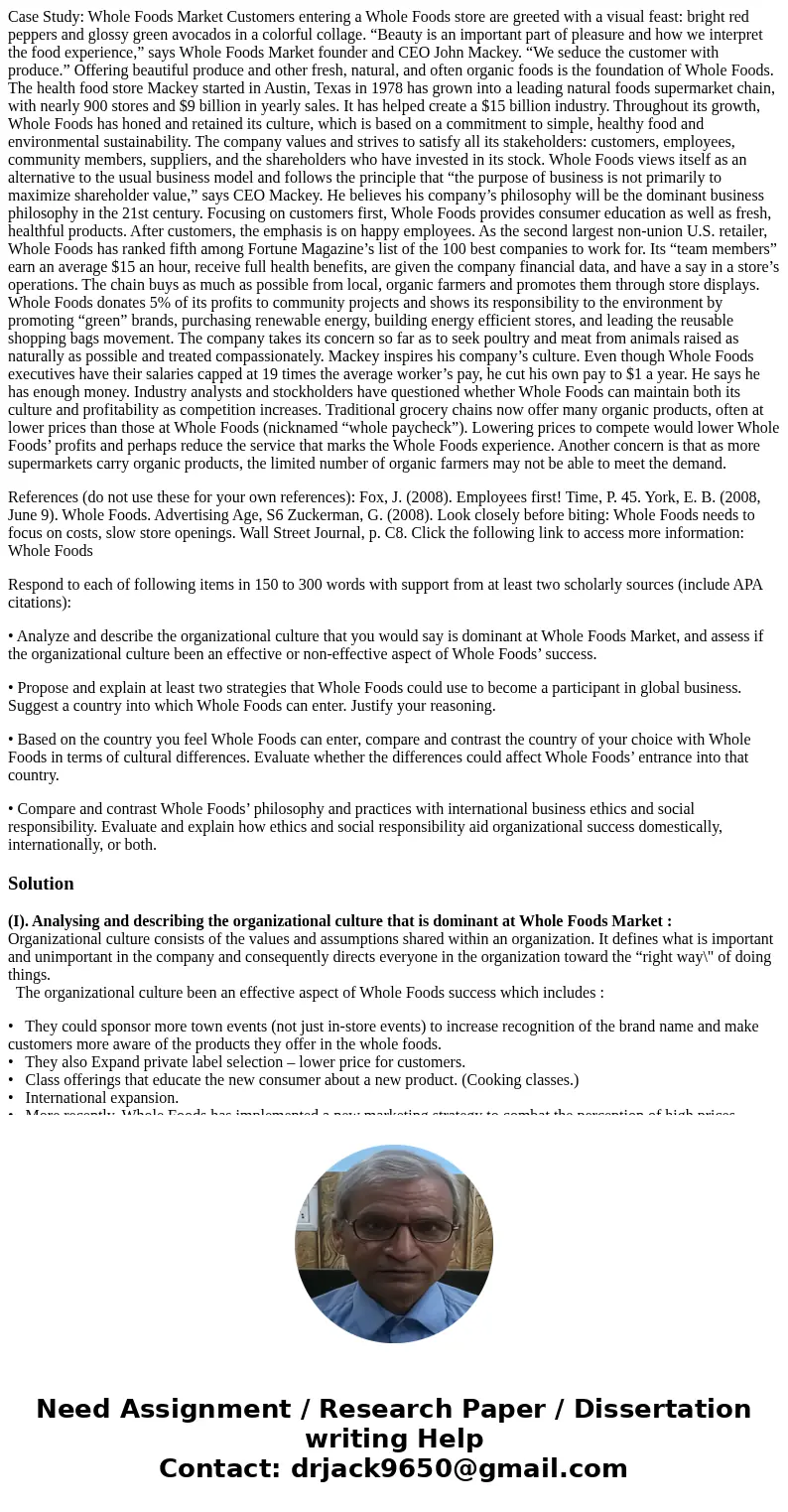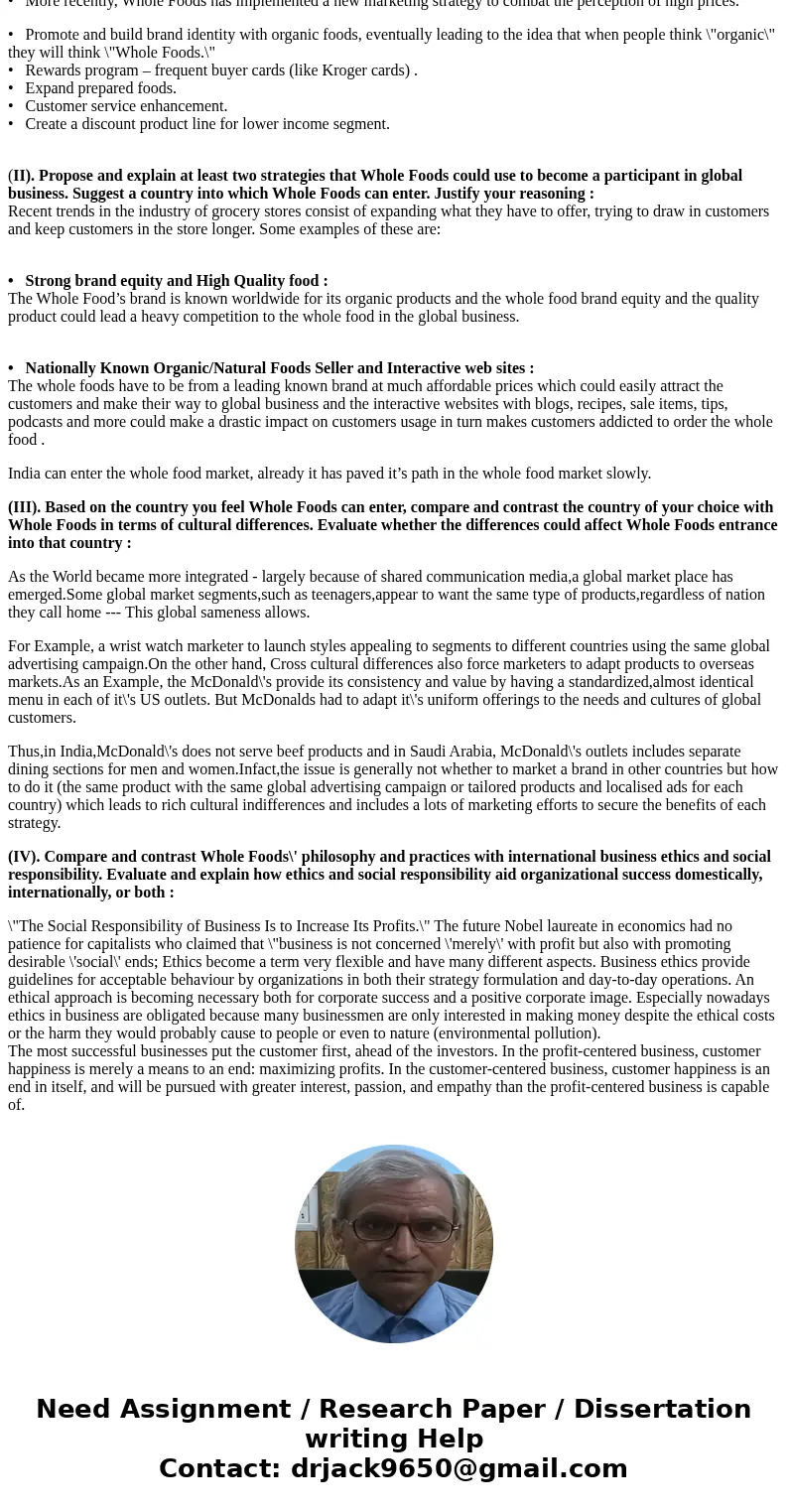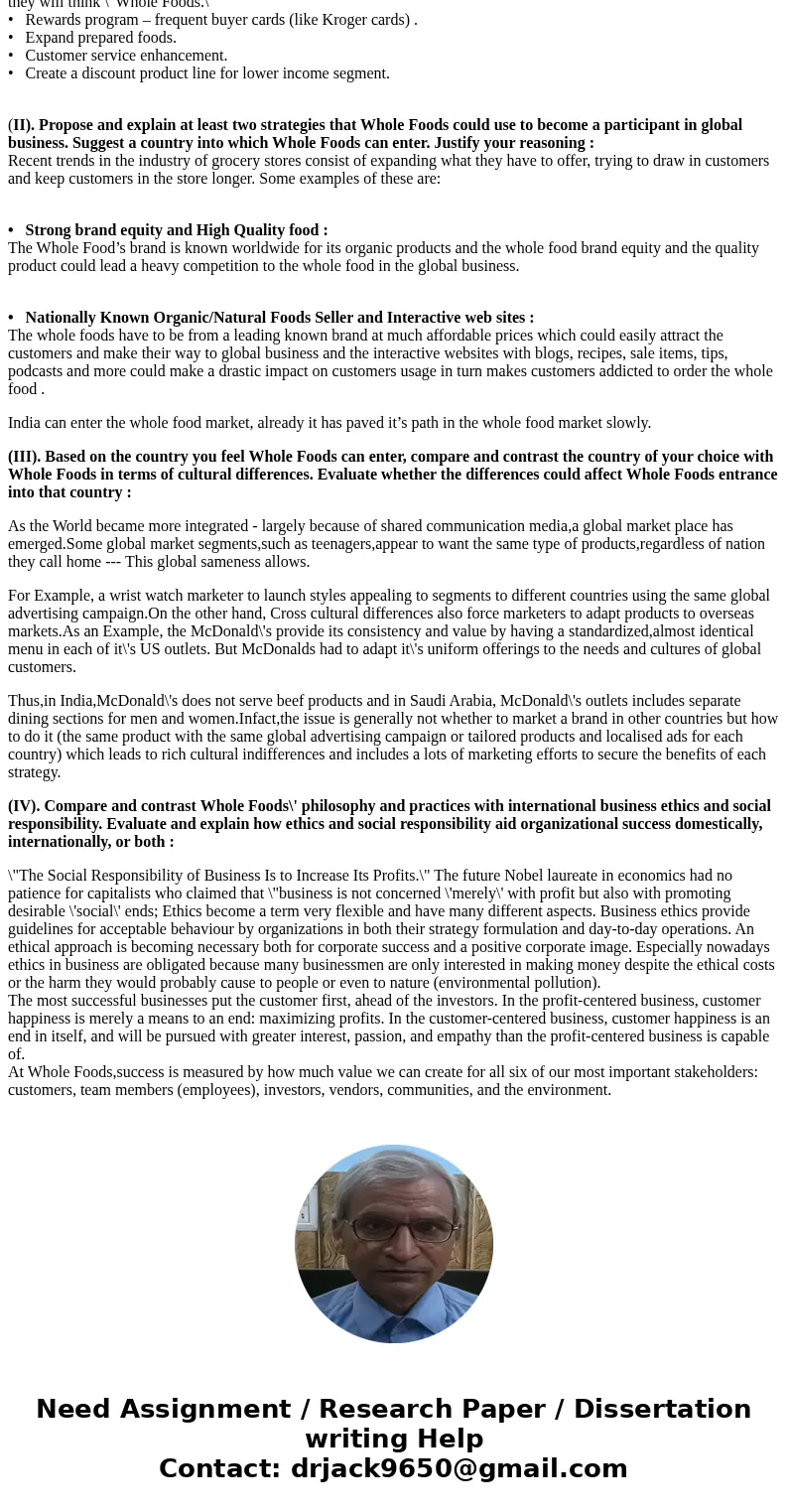Case Study Whole Foods Market Customers entering a Whole Foo
Case Study: Whole Foods Market Customers entering a Whole Foods store are greeted with a visual feast: bright red peppers and glossy green avocados in a colorful collage. “Beauty is an important part of pleasure and how we interpret the food experience,” says Whole Foods Market founder and CEO John Mackey. “We seduce the customer with produce.” Offering beautiful produce and other fresh, natural, and often organic foods is the foundation of Whole Foods. The health food store Mackey started in Austin, Texas in 1978 has grown into a leading natural foods supermarket chain, with nearly 900 stores and $9 billion in yearly sales. It has helped create a $15 billion industry. Throughout its growth, Whole Foods has honed and retained its culture, which is based on a commitment to simple, healthy food and environmental sustainability. The company values and strives to satisfy all its stakeholders: customers, employees, community members, suppliers, and the shareholders who have invested in its stock. Whole Foods views itself as an alternative to the usual business model and follows the principle that “the purpose of business is not primarily to maximize shareholder value,” says CEO Mackey. He believes his company’s philosophy will be the dominant business philosophy in the 21st century. Focusing on customers first, Whole Foods provides consumer education as well as fresh, healthful products. After customers, the emphasis is on happy employees. As the second largest non-union U.S. retailer, Whole Foods has ranked fifth among Fortune Magazine’s list of the 100 best companies to work for. Its “team members” earn an average $15 an hour, receive full health benefits, are given the company financial data, and have a say in a store’s operations. The chain buys as much as possible from local, organic farmers and promotes them through store displays. Whole Foods donates 5% of its profits to community projects and shows its responsibility to the environment by promoting “green” brands, purchasing renewable energy, building energy efficient stores, and leading the reusable shopping bags movement. The company takes its concern so far as to seek poultry and meat from animals raised as naturally as possible and treated compassionately. Mackey inspires his company’s culture. Even though Whole Foods executives have their salaries capped at 19 times the average worker’s pay, he cut his own pay to $1 a year. He says he has enough money. Industry analysts and stockholders have questioned whether Whole Foods can maintain both its culture and profitability as competition increases. Traditional grocery chains now offer many organic products, often at lower prices than those at Whole Foods (nicknamed “whole paycheck”). Lowering prices to compete would lower Whole Foods’ profits and perhaps reduce the service that marks the Whole Foods experience. Another concern is that as more supermarkets carry organic products, the limited number of organic farmers may not be able to meet the demand.
References (do not use these for your own references): Fox, J. (2008). Employees first! Time, P. 45. York, E. B. (2008, June 9). Whole Foods. Advertising Age, S6 Zuckerman, G. (2008). Look closely before biting: Whole Foods needs to focus on costs, slow store openings. Wall Street Journal, p. C8. Click the following link to access more information: Whole Foods
Respond to each of following items in 150 to 300 words with support from at least two scholarly sources (include APA citations):
• Analyze and describe the organizational culture that you would say is dominant at Whole Foods Market, and assess if the organizational culture been an effective or non-effective aspect of Whole Foods’ success.
• Propose and explain at least two strategies that Whole Foods could use to become a participant in global business. Suggest a country into which Whole Foods can enter. Justify your reasoning.
• Based on the country you feel Whole Foods can enter, compare and contrast the country of your choice with Whole Foods in terms of cultural differences. Evaluate whether the differences could affect Whole Foods’ entrance into that country.
• Compare and contrast Whole Foods’ philosophy and practices with international business ethics and social responsibility. Evaluate and explain how ethics and social responsibility aid organizational success domestically, internationally, or both.
Solution
(I). Analysing and describing the organizational culture that is dominant at Whole Foods Market :
Organizational culture consists of the values and assumptions shared within an organization. It defines what is important and unimportant in the company and consequently directs everyone in the organization toward the “right way\" of doing things.
The organizational culture been an effective aspect of Whole Foods success which includes :
• They could sponsor more town events (not just in-store events) to increase recognition of the brand name and make customers more aware of the products they offer in the whole foods.
• They also Expand private label selection – lower price for customers.
• Class offerings that educate the new consumer about a new product. (Cooking classes.)
• International expansion.
• More recently, Whole Foods has implemented a new marketing strategy to combat the perception of high prices.
• Promote and build brand identity with organic foods, eventually leading to the idea that when people think \"organic\" they will think \"Whole Foods.\"
• Rewards program – frequent buyer cards (like Kroger cards) .
• Expand prepared foods.
• Customer service enhancement.
• Create a discount product line for lower income segment.
(II). Propose and explain at least two strategies that Whole Foods could use to become a participant in global business. Suggest a country into which Whole Foods can enter. Justify your reasoning :
Recent trends in the industry of grocery stores consist of expanding what they have to offer, trying to draw in customers and keep customers in the store longer. Some examples of these are:
• Strong brand equity and High Quality food :
The Whole Food’s brand is known worldwide for its organic products and the whole food brand equity and the quality product could lead a heavy competition to the whole food in the global business.
• Nationally Known Organic/Natural Foods Seller and Interactive web sites :
The whole foods have to be from a leading known brand at much affordable prices which could easily attract the customers and make their way to global business and the interactive websites with blogs, recipes, sale items, tips, podcasts and more could make a drastic impact on customers usage in turn makes customers addicted to order the whole food .
India can enter the whole food market, already it has paved it’s path in the whole food market slowly.
(III). Based on the country you feel Whole Foods can enter, compare and contrast the country of your choice with Whole Foods in terms of cultural differences. Evaluate whether the differences could affect Whole Foods entrance into that country :
As the World became more integrated - largely because of shared communication media,a global market place has emerged.Some global market segments,such as teenagers,appear to want the same type of products,regardless of nation they call home --- This global sameness allows.
For Example, a wrist watch marketer to launch styles appealing to segments to different countries using the same global advertising campaign.On the other hand, Cross cultural differences also force marketers to adapt products to overseas markets.As an Example, the McDonald\'s provide its consistency and value by having a standardized,almost identical menu in each of it\'s US outlets. But McDonalds had to adapt it\'s uniform offerings to the needs and cultures of global customers.
Thus,in India,McDonald\'s does not serve beef products and in Saudi Arabia, McDonald\'s outlets includes separate dining sections for men and women.Infact,the issue is generally not whether to market a brand in other countries but how to do it (the same product with the same global advertising campaign or tailored products and localised ads for each country) which leads to rich cultural indifferences and includes a lots of marketing efforts to secure the benefits of each strategy.
(IV). Compare and contrast Whole Foods\' philosophy and practices with international business ethics and social responsibility. Evaluate and explain how ethics and social responsibility aid organizational success domestically, internationally, or both :
\"The Social Responsibility of Business Is to Increase Its Profits.\" The future Nobel laureate in economics had no patience for capitalists who claimed that \"business is not concerned \'merely\' with profit but also with promoting desirable \'social\' ends; Ethics become a term very flexible and have many different aspects. Business ethics provide guidelines for acceptable behaviour by organizations in both their strategy formulation and day-to-day operations. An ethical approach is becoming necessary both for corporate success and a positive corporate image. Especially nowadays ethics in business are obligated because many businessmen are only interested in making money despite the ethical costs or the harm they would probably cause to people or even to nature (environmental pollution).
The most successful businesses put the customer first, ahead of the investors. In the profit-centered business, customer happiness is merely a means to an end: maximizing profits. In the customer-centered business, customer happiness is an end in itself, and will be pursued with greater interest, passion, and empathy than the profit-centered business is capable of.
At Whole Foods,success is measured by how much value we can create for all six of our most important stakeholders: customers, team members (employees), investors, vendors, communities, and the environment.



 Homework Sourse
Homework Sourse